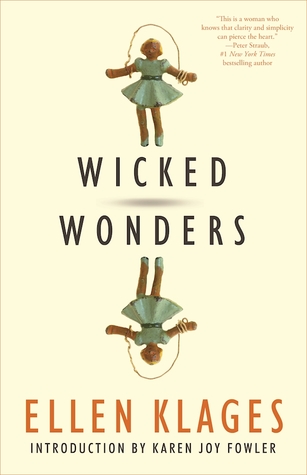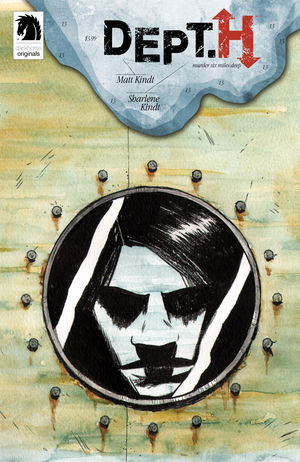
When thinking about dystopia recently for an essay (
which can be read here), our conversation raised the question of whether writers have
responsibility in how they depict dystopia and apocalypse. Is dystopian writing
a “warning system?” The question intrigued me, as both a reader of and a writer
of dystopian fiction, I wanted to think about it deeper. I also wanted to take
the question to some writers who tackle dystopia. So I sought out some of the
most interesting emerging SFF writers I know, and then barraged them with a
series of questions, which they were all considerate enough to answer in deeply
thoughtful ways. The writers I talked to were Kate Dollarhyde (SFF writer and
co-editor in chief of Strange Horizons), Brontë Wieland (SFF writer and
co-editor of the solar punk anthology Sunvault), Phoebe Wagner (SFF Writer and
co-editor of the solar punk anthology Sunvault), and Tony Quick (SFF writer).
The first question I asked tackled the question head on. It was a question I struggle with (as I
work on revising a dystopic sci-fi novel that tries to be hopeful): where is
the line drawn between being didactic (a quality I hate when I read it) and
being honest about what people have done to themselves and others? I also have
some pretty hard drawn lines when it comes to responsibility in terms of
horror: violence should never be depicted for strictly entertainment purposes
for example (y’all should hear my very long rant against the torture-porn
genre).
What responsibilities do we, as writers, have
in depicting dystopia and apocalypse? Should we spend as much time considering
the socially conscious aspects of our work as much as the narrative aspects?
KD: I believe writers have a responsibility to reflect an
experiential truth in their stories, whether real or imagined. The reality we
depict is, I think, a combination of the dystopia or apocalypse the writer is
working with and the social reality of their point of view characters.
If a writer's apocalypse is one based in climate collapse, for
example, the resonance of the depiction of that event or its aftermath depends
so much on the position—both physically and socially—of the protagonist. A rich
white man in post-water California and a working class Cuban woman in
post-coastline Florida will experience wildly divergent realities, both valid
as points of narrative inquiry, informed as much by their social position as by
the lack or abundance of water in their particular setting. The reader might
not have any experience with climate collapse, but they know what it's like to
inhabit a social reality, and one well-crafted will only make more relevant and
vital the narrative.
All of that is a roundabout way of saying that if a writer is
considering the narrative aspects of their work, they should by necessity be
considering the socially conscious aspects of their work. Calamity fiction is
about the collapse and radical restructuring of social order. It's my opinion
that the writer can't really have a coherent dystopic narrative that leans hard
on one and not the other.
BW: I believe that our
responsibility is to create depictions of the world as we see it, as we feel
it, as we want it to be, and as we believe it may become. Often the issues
facing us feel incalculable and insurmountable, and that’s where I believe
dystopia has its roots: those moments when the world is overwhelmingly shitty
and we begin to believe there’s no other path than something so dark. In that
way, yes, I think we are responsible for telling these stories, for depicting
the world how it presents itself to us.
The narrative and social aspects of our stories are inseparable,
and we should always consider the impact our writing will have.
TQ: I
want to be careful about assigning any specific “responsibility” to authors
because I’m afraid litmus tests can be limiting. The dystopian and apocalyptic
subgenres includes grim, somber novels in the vein of Cormac McCarthy’s The
Road or José Saramago’s Blindness but also includes chaotic
carnivals such as Kurt Vonnegut’s absurdist novel Cat’s Cradle or the
psychedelic dreamscapes of J.G. Ballard’s novels The Unlimited Dream Company
and The Drowned World. We’re standing under a wide umbrella here. We
should definitely give serious thought to the socio-political underpinnings of
our works but contemporary fiction shouldn’t be a soapbox. The contemporary
audience becomes defensive and closed off once they sense unpolished
propaganda. As artists, we’re challenged with hitching our larger societal
concerns to plots featuring smaller, intimate narratives our audience can
relate with. Fiction challenges us to show readers the ramifications of our
society’s slow decline and turn statistics into stories.
PW: That's the balance isn't it--which comes first,
social issues or narrative? How does one balance those ideas? I don't know. I'm
always fighting with being preachy. Dystopia seems to do that well, though. Mad Max: Fury Road always comes to mind when thinking of social
consciousness and narrative. While there are differing opinions on Fury Road, I
loved the film for its high-octane moments balanced with critiques on
everything from gender, human trafficking, capitalism, big oil, environmental
issues--the list goes on. I personally believe writers have a responsibility in
all their work. If I'm reading a dystopia and they aren't taking into
consideration that yes, while rape or torture or INSERT AWFUL THING HERE might
happen in an apocalypse, the writer must consider how those ideas will impact
the reader. If the writer is casually using the horror of an apocalypse
landscape just for its shock value without considering the social implications,
I won't keep reading. Conversely, a dystopia offers a canvas to explore the
dark side of humanity, which if done ethically and with empathy can be an
enlightening experience.
The next question I asked went back directly to something
Philippe had asked me in the previous essay: is the technical accuracy of these
depictions important? Again, it’s a question that I struggle with in terms of
my own writing. My thought is that good science-fiction should be able to see the
steps of how we got to the point depicted, even if those steps are not directly
spelled out on the page.
How much realism (in terms of how the
dystopia/apocalypse comes about, but also the fallout of it) is needed in a
dystopic depiction? Why?
KD: I think the writer only needs so much reality as is required to
make a dystopia feel truthful to the reader. The rub there is that every reader
has a different threshold for what feels true based on their own social reality
and how similar to or divergent from the social reality of the point of view
character they are.
Reality is, I think, an argument the writer makes to the reader.
A woman living in the United States today might not need much of an
argument—that is, injection of reality—to find The Handmaid's Tale convincing;
Atwood can take her dystopia to extremes of plausibility because her audience
doesn't need much help to follow her there. But a cisgender progressive man
might take more convincing. (Incidentally, I think that's why Atwood's MaddAdam
trilogy has such broad appeal—everyone who lives under capitalism recognizes
bits of their life in that dystopia.) You could, I think, make a similar
argument for white people in general and Butler's Parable of the Sower. Could
things really get that bad? To convince a reader who might ask
that question, who might doubt, the writer needs a more exhaustive argument.
So, in short, I believe the level of realism required in a
dystopic narrative is answered in who the author is writing for.
BW: For
me, a dystopia is most effective when I can see clearly how it was once related
to the world we live in. In the sense that I want the dystopias I read to be
believable extensions of the society they stem from, I think writers should
take great care to connect to a world their readers understand. In apocalypse
narratives, I think there is greater leeway in the origin of the disaster
event, but I still need to feel the way that the apocalypse informs and impacts
our idea of the present and its trajectory.
TQ: Realism
is subjective. When I read 20th century fiction, I’m constantly reminded how alien the stories
seem in our present day context. Look, I was born in the 20th
century but when I read about these characters whose misunderstandings could be
cleared up with a text message or read plots that would be resolved with a high
speed internet connection and a search engine, I wonder if I have more in
common with the science fiction protagonist who navigates a society transformed
by new, disruptive technologies. Beyond that, social media has revolutionized
how much insight and communication we have with people outside our immediate
orbit. We are learning via Facebook and Twitter and comments sections across
the internet that many of us don’t share the same reality.
But despite the age of “alternative facts” that dawn’s
orange on the horizon, we all should be able to agree that our actions
have concrete consequences. Chloe, I think you hit the bull’s eye with the word
“fallout.” More important than adhering to an imaginary consensus of realism,
we should aim to provide the audience with a sense the character’s actions matter.
By proxy, the audience may come to believe their actions have an impact and
maybe we can avoid the hammer’s fall. Maybe.
PW: I see that decision as belonging to the writer.
Dystopia/apocalypse settings can fall under any of the three major genre
branches (fantasy, science fiction, and horror) in my opinion, so the level of
realism depends on what the reader needs in order to believe the story. As a
reader and writer, I do need realism when it comes to the characters' reactions
to the landscape. The environment needs to influence them. If the environment
isn't impacting the characters, then why write a dystopia at all?
Finally, I asked the question
that gets to the root of all good writing. Why do you do what you do? Why is
this important to you? Dystopia is important to me because it shows a path not
to take, a warning. It also shows that we do go on, despite all of this, we go
on. Dystopia to me has always been a hopeful genre, because it shows we keep
trying.
Why do you choose to write about dystopias?
KD: For me, dystopia's appeal lives in the braiding of hope and
hopelessness.
Every person's present day—from 50,000 years ago to right now—is
all fucked up. Our societies teeter always on the edge of ruin. Our individual
lives teeter always on the edge of death. One person in the right place needs
only to make one wrong choice to send us careening over the edge of oblivion.
Someone launches a nuke. Someone mows me down in a crosswalk. Dystopias reflect
that reality, that ever-present possibility of the end of everything. Dystopias
say your hopelessness is not insane. You are not alone in
being afraid.
But dystopias are not a nihilistic surrender to the uncaring
smackdown of the universe, because hope is as much baked in to their narrative
structures as hopelessness. A successful dystopic narrative is to me at least
in part a promise: we can fuck everything up and still make it out alive. Even
The Road, the most relentlessly depressing apocalypse story I've read, ends
with hope. Not hope that everything will be as it was, or that everything will
be okay, or that we won't lose everything that matters to us along the way, but
that it's possible to keep going.
BW: When I write dystopia, what’s on my mind is
usually a single action or behavior or sight that has struck me as unexpectedly
and scarily oppressive. Often, it’s an everyday occurrence that presents itself
in a new light, or it’s something I haven’t stopped to think about before, and
I try to see the extension of the action and its consequences. Where will we go
if we never stop to consider the ways we behave and let ourselves be
influenced? That’s the question I try to answer in writing dystopia.
TQ: There’s this quote by William
Gibson I keep coming back to time and again: “Nobody can know the real future.
And novels set in imaginary futures are necessarily about the moment in which
they are written.” Despite my tendency to draw dark futures, I’m actually
optimistic about humanity’s chances of survival. We are a stubborn species who
have harnessed nature to the point that survivalist tales are our entertainment
rather than, you know, our daily lives. Whether we continue on as tribes of
neo-cavemen scattered across a bombed out landscape, as space-faring refugees
colonizing the solar system, or genetically altered shades of ourselves
retrofitted to fit our new environment, we are not going down as a species
without a fight.
I’m concerned about our immediate present and near future,
what ways we might maim ourselves on our road to that future and how we might
rise above ourselves. Recently, one of my advisers expressed his exhaustion
with the sheer pessimism of post-apocalyptic science fiction and a desire to
see a return of optimism in the genre. There’s something to be said for this:
writers can lean heavy on diagnosing society’s issues and genre’s unique
capacity to imagine alternatives allows our fiction to do more. But that said,
I don’t see dystopia and apocalyptic settings as a popular, waning trend but
instead a subgenre that speaks to a wartime generation raised on Y2K scares,
9/11 fallout, 2012 Mayan calendar predictions, random acts of domestic and
foreign terrorism, 24-hour doomsday prophets, and seismic societal changes all
streaming to us live. Why are we surprised the generation who has been told
“the end is nigh” since we were knee high write about futures where those
predictions bear fruit?
Our contemporary society has a number of pressing issues:
institutional racism, indoctrinated sexism, homophobia, xenophobia, class
inequality, violations of rights, and so on. No one science fiction writer
could ever tackle all these issues with depth and sincerity: we need an army.
Science fiction is a useful tool for indirectly interrogating how society is
organized without limiting ourselves to what “is possible” and “isn’t
possible.” Those who are most impacted by society’s problems and are only now gaining
a foothold from which we can speak aren’t ready to abandon the dystopian genre
when it’s so useful to portraying shades of our unacknowledged reality.
PW:
I write about dystopias
as a way to explore the near future, a future which seems to be coming closer
and closer. What happens when humanity is pushed to the end of existence? What
breaks down, what survives? Now, working backwards from those depictions, how
can I as an individual work to stop that degradation of society? For me,
dystopias aren't fun an games but a way to explore big problems--climate
change, the collapse of capitalism, gender, human and nonhuman relationships.
If my dystopia isn't dealing with social issues, I usually avoid the setting.
There's enough depressing literature out there, I'm not interested in adding to
it unless some good might come from it.
So
dystopia creators and consumers, what are your thoughts on these questions (and
the thoughts on them here)? I’d love to hear other voices on this, commenting
here or discussing on Twitter (@PintsNCupcakes and @nerds_feather). You can also
tag in any of the lovely writers above (Kate is @keightdee, Tony is
@tonyquickpov, Bronte is @beezyal, and Phoebe is @pheebs_w).
























